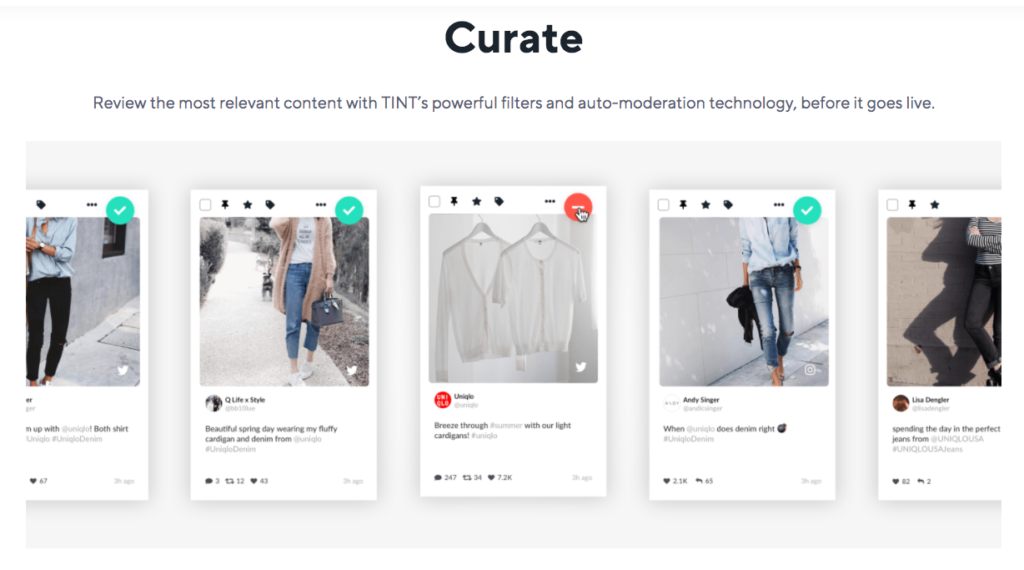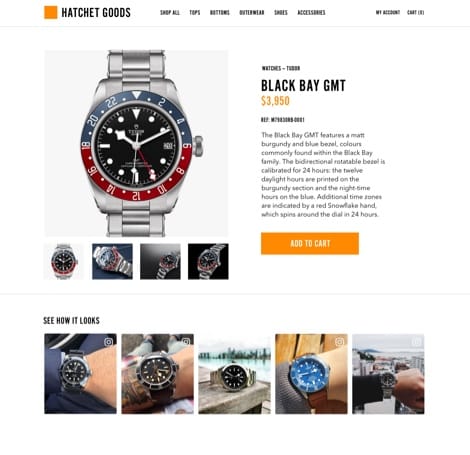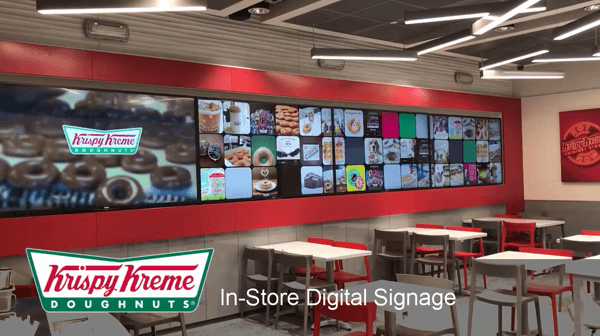Brands have known the power of word-of-mouth marketing for years—the opinion of a family member, friend or colleague can make or break the decision to purchase a new car, eat at a particular restaurant or sign on for an enterprise software solution. And with social interactions happening more online, the methods by which we vouch for products and services within our networks have followed. Today, user-generated content (UGC) that showcases the merits of a brand’s product or service is equivalent to that in-person conversation of yesteryear.
If not already doing so, companies should take notice of customers expressing love for a brand online. With a defined UGC strategy, your company can extend the reach of your customers’ posts to connect with a multitude of new prospects. The campaigns you create will lead to increased conversions and—just as important—stronger bonds with your most ardent supporters.
Creating a UGC strategy from scratch can be tricky. That’s why TINT created this guide to getting started with UGC. In it, you’ll learn how to source UGC, how to encourage consumers to create content, the importance of user rights and strategies for repurposing UGC.
This guide is just a starting point for how TINT can assist you and your marketing team. For further questions, schedule a demo and visit with one of our TINT success managers—they have deep experience in helping brands implement UGC into their marketing stack. For now, let’s get you started on learning some of the essentials.
Discovering UGC in Social Networks
Prior to social networks, consumer-driven UGC was largely confined to unstructured blogs, review sites and message boards. Marketers had to put in effort to discover who was talking about their products online. Today, social media platforms have enabled brands to listen to what consumers are saying about them. In fact, many brands now have social support teams to ensure that complaints are fielded and praise is acknowledged.
Furthermore, marketers have the ability to search for photos and status posts praising their products. There are three ways that you can discover UGC in social networks: manually searching social networks, using a social content aggregator and implementing a machine learning process.
Manually Searching Social Networks
Most social networks offer the ability to search status posts by using Boolean operators. This lets brands manually type in text strings or even their URLs to see what people are saying and sharing about the brand.
In the same way that you might search for an email, you can manually search Twitter by visiting http://search.twitter.com. Additionally, you can see the latest posts featuring a specific hashtag by clicking that hyperlinked text in the social feed and then sorting by the top or latest tweets. Most major social network searches operate in a similar fashion.
Additionally, branded mentions are likely showing up in your company’s official social media account, so anytime a consumer tags your brand, that notification will pop up on the back end of the social account.
There are some challenges with these manual processes. First, you have to go through the hoops within each social network one by one, a time-consuming proposition and even more so if there are multiple branded accounts. Second, some of the branded mentions may show up only if you have native platform access to that social media account; this is typically a nonstarter for most major brands with strict social media governance in place. Finally, a manual process makes it all too easy to miss an important piece of UGC when searching through the noise of social platforms.
Using a Social Content Aggregator
A far superior option for discovering UGC is to use a social content aggregator. With a platform like TINT’s, you can define the parameters, hashtags and social media handles you want to search in multiple social networks. In fact, TINT has the ability to search over 15 platforms at once and filter posts by geography, date and audience engagement to help present the most important posts for your brand.

Using a social content aggregator saves a marketing team time, especially because you have the ability to easily secure user rights and cross-publish the content to your branded platforms. However, there are still manual processes involved, and you do have to ensure that you have the resources to curate social content.
Implementing Machine Learning
By far the best way to surface relevant UGC is to tap into the power of machine learning. You will initially need a person to manually sift through social media content and identify which posts are most relevant to your brand. During this process, a machine learning algorithm is studying the human’s actions to figure out what makes for the most desirable posts.
This is what HUE, a deep learning tool by TINT, does inside our platform. Not only does HUE learn from your actions to build a unique content profile based on your preferences, it also uses metrics such as CTR and engagement rates to further understand which content your consumers enjoy the most.
With machine learning, the massive amount of online content can be culled down to a few smart selections that are manageable by a human team. Your team will get the best pieces of UGC and always have the final say on which ones to repurpose.
Encouraging Consumers to Create UGC
Many household-name brands have an abundance of UGC, but many of companies need help in encouraging consumers to create social media posts and photos that feature your brand’s products. Fortunately, the same tactics for generating UGC that work for big-name brands also work for small companies. Here are our top strategies for getting your devotees to speak up online.
Hashtag Campaigns and Contests
One of the tried-and-true methods of generating UGC is to directly ask consumers to create it by starting a hashtag campaign or contest. Defining a branded hashtag for consumers to use makes it easy for your team to zero in on customer posts by searching on that unique term.
Travelocity is one brand that did this exceptionally well with their #IWannaGo campaign and contest. The brand encouraged users to post about their dream vacation with the #IWannaGo hashtag by giving away a free trip. This campaign saw over 25,000 people create content with the hashtag in an effort to win the grand prize, all while promoting Travelocity to their social connections.
Influencer Partnerships
Another way to get people to create UGC is to partner with social media influencers on a campaign. Working with an influencer to get a flattering review of your brand is table stakes; take it to the next level by asking that influencer to ask their network to create UGC with your branded hashtag.
The best examples of this are when influencers present a provocation to their audience in branded hashtag challenges on TikTok. Guess recently collaborated with TikTok influencers for the #InMyDenim challenge, for which people were asked to submit a video of their denim style with the associated hashtag. The campaign was a smash—as described in TINT’s guide to advertising on TikTok—with over 10.5 million video views that contained the hashtag!
And if you think an influencer has to have millions of followers to be effective, think again. Partnering with microinfluencers and nanoinfluencers is one of the hottest digital marketing trends around—in spite of a lower follower count, their audiences tend to be more engaged.
Securing the Rights to Reuse UGC
As more organizations realize the power of UGC, they still lack an understanding of the importance of securing UGC user rights. Even though it’s become acceptable for the average person to screen-grab images for their social media posts and share the latest memes, that kind of behavior can get a brand in trouble. Simply put, users own the copyrights to their creative works, which includes photos they take and post online.
Not only is it unseemly for brands to repurpose a consumer’s image without permission, it could result in a legal skirmish. The only way that a brand should reuse consumer content is with explicit permission.
TINT grasps the importance of user rights, which is why a workflow was built into our platform to help brands with content rights management. With just a few clicks, you can send a personal note to the user via direct message, asking them for permission for your brand to reuse the photo. This interaction is documented and available as proof that the person gave you permission to repurpose their content. Furthermore, TINT’s copyright detection algorithm can uncover whether the user is the originator of the image or if they copied it from somewhere else.
Make no mistake, securing user rights matters. Not only can you deliver a positive interaction with your most loyal fans, getting explicit permission to repurpose UGC can protect your brand from any issues down the road.
Repurposing UGC on Branded Properties
Now that you’ve successfully encouraged consumers to create branded UGC and have methods for discovering it, the important question is what the heck are you going to do with it? In the past, the simple act of having users create this content to generate brand awareness was enough. But if you stop there, you are missing out in a major way.
This content is equivalent to massive word-of-mouth marketing, so don’t let it die on the vine in a lone user’s social network. Savvy brands know that the real magic lies in repurposing UGC across branded properties to help convert prospects down the funnel. Here are several ways that you can do this.
Amplify a Consumer’s Post in Your Social Network
Often, branded social media accounts have a higher number of followers and different audience subsets than the consumer who created the social post featuring your brand. While it may be the most basic way of repurposing UGC, simply reusing the photo in your branded social media channels can offer you a lot in return.
Worried about overrunning your permanent social media feed, such as your profile’s Instagram wall? Consider reposting UGC in an ephemeral way, like with an Instagram story, a strategy that Maui Brewing Company applies really well.
Create Social Proof in Ecommerce Product Galleries
While having a staged product photo with crisp lighting and a white background is absolutely necessary, consumers also want to see what your product looks like in the wild. One way to do this is by repurposing UGC into product galleries.
Do this by either including consumer shots in the gallery for a particular product or creating a landing page with all UGC pictures in one place. And with TINT, you can make those images shoppable with hotspots and CTAs so an online shopper can instantly make a purchase.

Show Brand Love in Web Galleries and Digital Displays
It remains as true as ever that people want to be seen and heard. Responding to this desire by showing off your loyal fans’ photos in a gallery will make them love you even more. And with TINT, you can easily create a collage of UGC photographs in an online gallery or digital display.
With online social galleries, user photographs can quickly land in an elegant layout on a dedicated landing page. It provides some bragging rights for your customers to say that they were featured on your site. Digital displays in the physical world take this up a notch by featuring a user’s photo in real time on physical displays. For a brand advocate, this feeling is akin to that of a passionate sports fan being shown on the jumbotron during a game.
One brand that implemented both of these UGC strategies well was Krispy Kreme. The donut chain wanted to dominate the #NationalDonutDay conversation and UGC was key to rising above the noise. In addition to the official hashtag, Krispy Kreme created a branded hashtag and encouraged customers to append it to their posts. This made it easy for their marketing team to source UGC.

Krispy Kreme featured the best customer pictures from the day in an online gallery and in-store digital displays. The results were astounding. Web traffic increased from 25,000 sessions to over 330,000, and Krispy Kreme was Twitter’s most-mentioned brand on National Donut Day.
Using Consumer Photos in Paid Media Efforts
As marketers, we sometimes find it hard to think like the customer, instead living in our own world of detailed product information. We focus on the technical specifications of our new gadget, the square footage of our spacious hotel suite or getting the perfect shot of our limited-release menu item. While we live and breathe a campaign for months, it’s easy to forget the one thing that matters to the consumer: Is the product awesome or not?
It’s in answering this question that UGC shines. And it may be worth putting some paid media behind those images to show on a large scale what real customers think about your product. Case in point: Apple’s “Shot on iPhone” campaign.
Instead of speaking to the incredible technology behind the cameras on their phone, Apple let its users do the talking by showing what they created. The campaign initially featured photos and videos by everyday users and has now progressed on to high-production videos, such as one by Selena Gomez and an impressive short film by stuntman-turned-director David Leitch called Snowbrawl. But even as the user-generated content turned from amateur to professional, Apple’s message has been clear: this is what you can do on our device.
Getting Started with a UGC Program, Powered by TINT
This guide to UGC was created as a primer for brands looking to implement consumer content into their marketing programs. While it has covered many of the most common topics and inquiries, the TINT customer success team is ready to discuss your unique needs and assist you further. Be sure to request a demo today to book a time with a member of our team. Learn more about how TINT helps the world’s best companies generate greater audience engagement and increase sales conversion.
Garrett Heath is a social media and content marketing consultant and founder of MarketingBytes.io. Header photo by AbsolutVision on Unsplash.




